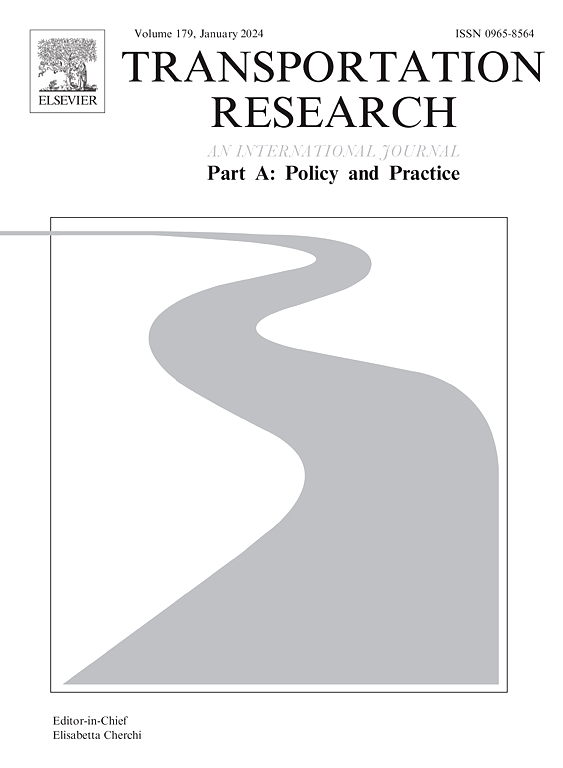Equity and efficiency trade-off in allocating airport and airspace capacity in a multiple airport system
IF 6.8
1区 工程技术
Q1 ECONOMICS
Transportation Research Part A-Policy and Practice
Pub Date : 2025-09-02
DOI:10.1016/j.tra.2025.104645
引用次数: 0
Abstract
The objective of airport slot allocation is to distribute slots to airlines following specific procedures and regulations. With the rapid growth of air traffic and increasing congestion at major airports, optimizing slot allocation has become a critical issue to enhance operational efficiency and mitigate delays. While extensive research has been conducted on slot allocation at individual airports, less attention has been given to the complexities of slot allocation in a Multiple Airport System (MAS), where airlines must compete for both airport and airspace resources. In a single airport slot allocation, the only resource that airlines compete for is airport capacity; in an MAS, there are several resources that must be taken into account, such as airport capacity and fix (i.e., route point) capacity. In this article, a model is presented that considers the capacity of the airport and airspace, as well as the efficiency and fairness among airlines operating in the MAS. The goal of the model is to minimize total slot displacements of the MAS, while satisfying airport capacity and fix capacity constraints, operational constraints, and fairness constraints. To measure fairness, comprehensive fairness metrics for airlines are developed. The trade-off between efficiency and equity in an MAS slot allocation problem is investigated, with the Price of Fairness(POF) taken into account. The proposed model is tested using MAS slot request data from an MAS in China. The results demonstrate that the model can achieve a better Gini-based fairness by sacrificing a certain amount of slot displacements. These findings have significant implications for slot regulators in improving the efficiency of managing airport slot resources within an MAS.
多机场系统中机场与空域容量分配的公平与效率权衡
机场机位分配的目的是按照特定的程序和规定将机位分配给航空公司。随着空中交通的快速增长和主要机场拥堵的加剧,优化机位分配已成为提高运营效率和减少延误的关键问题。虽然对单个机场的机位分配进行了广泛的研究,但对多机场系统(MAS)中机位分配的复杂性关注较少,因为航空公司必须同时竞争机场和空域资源。在单个机场时段分配中,航空公司竞争的唯一资源是机场运力;在MAS中,必须考虑几个资源,例如机场容量和固定(即路线点)容量。在本文中,提出了一个模型,考虑了机场和空域的容量,以及在MAS中运营的航空公司之间的效率和公平性。该模型的目标是在满足机场容量和固定容量约束、运营约束和公平性约束的情况下,最小化MAS的总槽位位移。为了衡量公平,我们开发了航空公司的综合公平指标。在考虑公平价格(POF)的情况下,研究了MAS时隙分配问题中效率与公平之间的权衡。利用中国MAS的槽位请求数据对该模型进行了测试。结果表明,该模型通过牺牲一定的槽位位移,可以获得更好的基于基尼系数的公平性。这些发现对航段监管机构提高MAS内机场航段资源管理效率具有重要意义。
本文章由计算机程序翻译,如有差异,请以英文原文为准。
求助全文
约1分钟内获得全文
求助全文
来源期刊
CiteScore
13.20
自引率
7.80%
发文量
257
审稿时长
9.8 months
期刊介绍:
Transportation Research: Part A contains papers of general interest in all passenger and freight transportation modes: policy analysis, formulation and evaluation; planning; interaction with the political, socioeconomic and physical environment; design, management and evaluation of transportation systems. Topics are approached from any discipline or perspective: economics, engineering, sociology, psychology, etc. Case studies, survey and expository papers are included, as are articles which contribute to unification of the field, or to an understanding of the comparative aspects of different systems. Papers which assess the scope for technological innovation within a social or political framework are also published. The journal is international, and places equal emphasis on the problems of industrialized and non-industrialized regions.
Part A''s aims and scope are complementary to Transportation Research Part B: Methodological, Part C: Emerging Technologies and Part D: Transport and Environment. Part E: Logistics and Transportation Review. Part F: Traffic Psychology and Behaviour. The complete set forms the most cohesive and comprehensive reference of current research in transportation science.

 求助内容:
求助内容: 应助结果提醒方式:
应助结果提醒方式:


